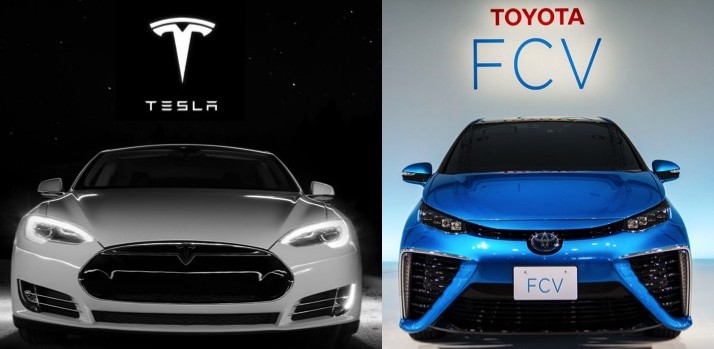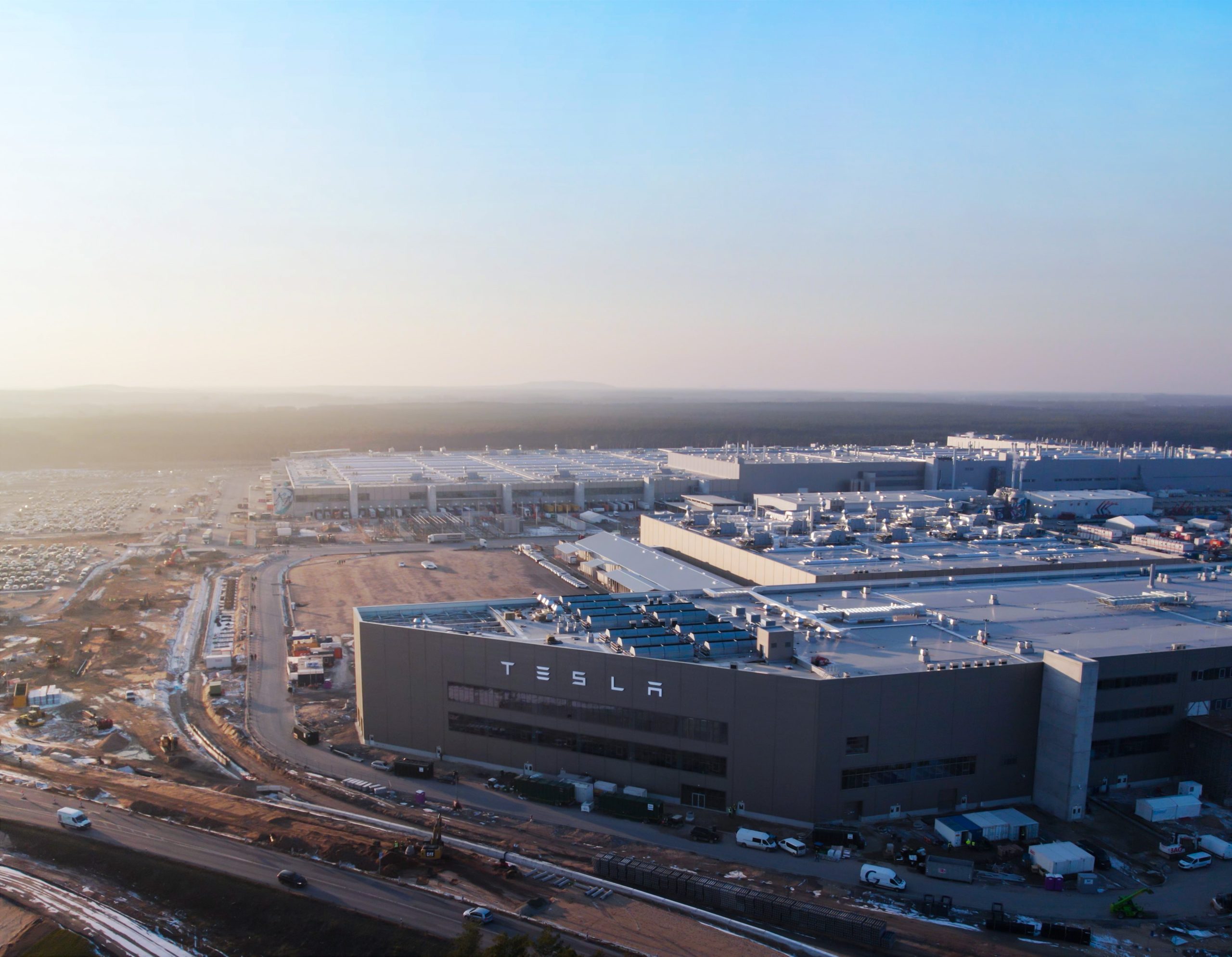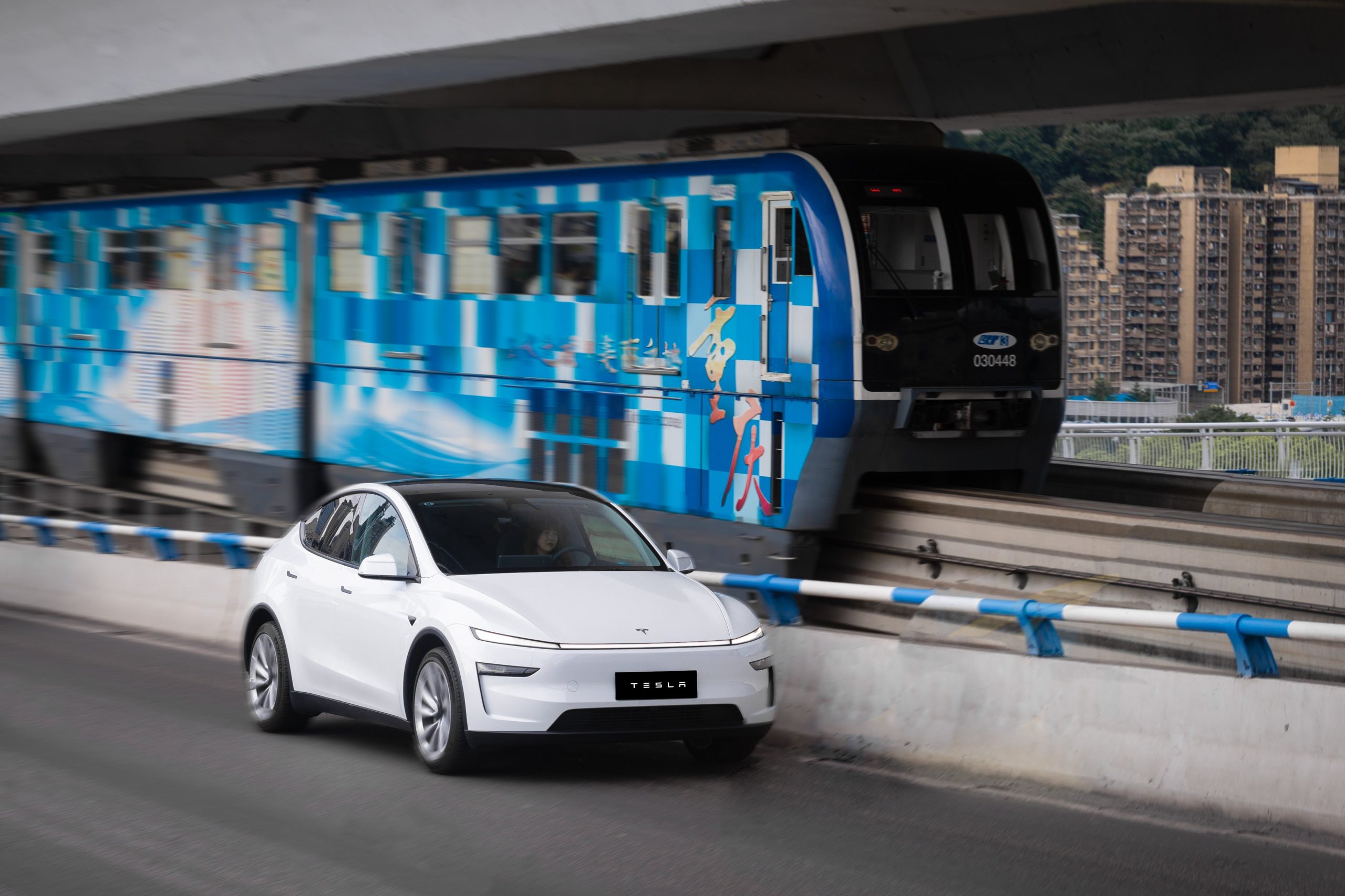

News
Tesla Model S vs. Toyota Mirai Comparison
With the introduction of the new hydrogen-powered Toyota Mirai (the name means “future” in Japanese), there has been a lot of media hype about vehicles that use hydrogen fuel cells as their power source. Toyota, Honda and a number of other automobile companies have announced plans to build cars based on fuel cell technology.
Fundamentally, a hydrogen fuel cell produces electricity via an electro-chemical reaction that drives an electric motor that creates the motive force for a car. The technology requires high-pressure storage of liquid hydrogen, a fuel cell to convert the H2 to electrons, a control system to deliver the resultant electricity to an electric motor and/or battery that in turn drives the wheels of the vehicle. It’s a workable, if somewhat complex system that produces zero emissions and water as a by-product.
In the media, there are three major claims that are being made about cars powered by hydrogen: (1) that H2 is a 21st century energy source and will ultimately become the preferred power source for automobiles; (2) that hydrogen-powered fuel cells represent a significant improvement in environmentally safe automotive fuel, and (3) that cars like the Toyota Mirai represent a major threat to battery electric vehicles (BEVs) like the Tesla Model S.
Are any or all of these claims true? We thought we’d take a look.
After going through the popular literature and government/academic reports, we decided that the best way to present the array of information collected was with an infographic, “Tesla Model S vs. Toyota Mirai: A Technology/Vehicle Comparison,” that examines four broad categories of concern:
- underlying technology that powers the vehicle
- the two vehicles themselves
- technology required for refueling the vehicle, and
- environmental impact
Tesla Model S vs. Toyota Mirai
Technology
EV technology has been around for 100 years. It represents a remarkably simple method for automotive power that is constrained solely by the capacity of the vehicle’s batteries. Fuel cells are evolving rapidly and provide more energy capacity than modern Li-Ion batteries, but they require liquid hydrogen to be stored on board the vehicle in pressurized tanks. The Tesla Model S has an energy capacity of either 60 kWh or 85 kWh while the Toyota Mirai produces 114 kWh. The overall energy efficiency (from an environmental viewpoint) of BEVs is dependent on the efficiency of the electric grid from which a BEV obtains its diet of electrons. The efficiency of hydrogen-powered cars is impacted by the process that extracts hydrogen from other sources and the method by which hydrogen is transported to a refueling station.
The winner: It’s close, but the simplicity of the BEV system gives the underlying technology of the Model S a slight edge.
The Vehicles
Both the Tesla Model S and the Toyota Mirai are expensive, but that’s the price of new technology. The Model S is a premium, high performance automobile in ever sense of the word. It is a visually beautiful car that conjures images of a Aston Martin or Jaguar and has been lauded as one of the best sedans in the world. It has won praise from virtually every automotive media source, and is one of the safest, roomiest cars on the planet. The Toyota Mirai has an eccentric look that gives it a boxy Prius-like feel. It appears to provide good, basic transportation, but it is not for those who want a bit more than good, basic transportation. Finally, the Tesla Model S is here today. By 2017, there will be about 160,000 Model S vehicles on the road. Toyota projects that only 3,000 Mirais will be in the field by the same date.
The winner: No contest! The Model S is far superior to the Mirai in virtually every respect except for range.
Fueling the Vehicle
In our view, one of the major benefits of BEVs is that you refuel them at home, overnight, while you’re sleeping, so that your Model S is “full” every morning. Unless you travel long distances on a regular basis, you will rarely need a Tesla Supercharger or any other refueling source away from home. That’s huge, and often get’s lost in the discussion of “range anxiety” that always seems to invade the thinking of those who don’t own a Model S. Although fuel cells are sexy, it seems odd to us that Toyota has returned to a 20th century fueling station paradigm. In essence, there is little difference between refueling a Mirai and refueling a Camry. Sure, the fuel is different, but you have to hunt for a specific refueling station as your Mirai slowly depletes its hydrogen. No charging at home—ever.
The winner: No contest! Refueling your vehicle at home is a convenience that represents 21st century thinking. Model S provides that convenience. Mirai does not.
Environmental Impact
Both the Model S and the Mirai are environmentally impressive. Both have zero emissions and relatively low “well-to-wheel” inefficiencies. In our view, the beauty of a BEV is that it becomes increasingly friendly to the environment as our electric grid infrastructure improves. There is no need to separately transport fuel to a refueling station (a requirement for a hydrogen fuel cell vehicle) eliminating both the cost and the environmental impact of secondary fuel transport.
The winner: It’s a toss up. Both cars are environmentally friendly and both will improve as the grid becomes cleaner and as hydrogen extraction processes become more efficient and cost effective.
As a young engineering student I was taught that when you consider alternative systems that both achieve the same result, always choose the less complex approach. That’s common sense, but it appears that when faced with the same choice, Toyota chose the more complex option. Possibly, their engineers or marketing people were driven by concern about range, but that’s simply not as big an issue as they think it is. BEVs represent simplicity, and in an increasingly complex world, that’s something that many consumers like.
Is the Mirai (or another similar H2 vehicle) a “Tesla Killer”? Not a chance!
Originally published on EVannex

News
Tesla Giga Berlin draws “red line” over IG Metall union’s 35-hour week demands
Factory manager André Thierig has drawn a “red line” against reducing Giga Berlin’s workweek to 35 hours, while highlighting that Tesla has actually increased its workers’ salaries more substantially than other carmakers in the country.

Tesla Giga Berlin has found itself in a new labor dispute in Germany, where union IG Metall is pushing for adoption of a collective agreement to boost wages and implement changes, such as a 35-hour workweek.
In a comment, Giga Berlin manager André Thierig drew a “red line” against reducing Giga Berlin’s workweek to 35 hours, while highlighting that Tesla has actually increased its workers’ salaries more substantially than other carmakers in the country.
Tesla factory manager’s “red line”
Tesla Germany is expected to hold a works council election in 2026, which André Thierig considers very important. As per the Giga Berlin plant manager, Giga Berlin’s plant expansion plans might be put on hold if the election favors the union. He also spoke against some of the changes that IG Metall is seeking to implement in the factory, like a 35-hour week, as noted in an rbb24 report.
“The discussion about a 35-hour week is a red line for me. We will not cross it,” Theirig said.
“(The election) will determine whether we can continue our successful path in the future in an independent, flexible, and unbureaucratic manner. Personally, I cannot imagine that the decision-makers in the USA will continue to push ahead with the factory expansion if the election results favor IG Metall.”
Giga Berlin’s wage increase
IG Metall district manager Jan Otto told the German news agency DPA that without a collective agreement, Tesla’s wages remain significantly below levels at other German car factories. He noted the company excuses this by referencing its lowest pay grade, but added: “The two lowest pay grades are not even used in car factories.”
In response, Tesla noted that it has raised the wages of Gigafactory Berlin’s workers more than their German competitors. Thierig noted that with a collective agreement, Giga Berlin’s workers would have seen a 2% wage increase this year. But thanks to Tesla not being unionized, Gigafactory Berlin workers were able to receive a 4% increase, as noted in a CarUp report.
“There was a wage increase of 2% this year in the current collective agreement. Because we are in a different economic situation than the industry as a whole, we were able to double the wages – by 4%. Since production started, this corresponds to a wage increase of more than 25% in less than four years,” Thierig stated.
News
Tesla is seeing a lot of momentum from young Koreans in their 20s-30s: report
From January to November, young buyers purchased over 21,000 Teslas, putting it far ahead of fellow imported rivals like BMW and Mercedes-Benz.

Tesla has captured the hearts of South Korea’s 20s-30s demographic, emerging as the group’s top-selling imported car brand in 2025. From January to November, young buyers purchased over 21,000 Teslas, putting it far ahead of fellow imported rivals like BMW and Mercedes-Benz.
Industry experts cited by The Economist attributed this “Tesla frenzy” to fandom culture, where buyers prioritize the brand over traditional car attributes, similar to snapping up the latest iPhone.
Model Y dominates among young buyers
Data from the Korea Imported Automobile Association showed that Tesla sold 21,757 vehicles to the 20s-30s demographic through November, compared to BMW’s 13,666 and Mercedes-Benz’s 6,983. The Model Y led the list overwhelmingly, with variants like the standard and Long Range models topping purchases for both young men and women.
Young men bought around 16,000 Teslas, mostly Model Y (over 15,000 units), followed by Model 3. Young women followed a similar pattern, favoring Model Y (3,888 units) and Model 3 (1,083 units). The Cybertruck saw minimal sales in this group.
The Model Y’s appeal lies in its family-friendly SUV design, 400-500 km range, quick acceleration, and spacious cargo, which is ideal for commuting and leisure. The Model 3, on the other hand, serves as an accessible entry point with lower pricing, which is valuable considering the country’s EV subsidies.
The Tesla boom
Experts described Tesla’s popularity as “fandom culture,” where young buyers embrace the brand despite criticisms from skeptics. Professor Lee Ho-geun called Tesla a “typical early adopter brand,” comparing purchases to iPhones.
Professor Kim Pil-soo noted that young people view Tesla more as a gadget than a car, and they are likely drawn by marketing, subsidies, and perceived value. They also tend to overlook news of numerous recalls, which are mostly over-the-air software updates, and controversies tied to the company.
Tesla’s position as Korea’s top import for 2025 seems secured. As noted by the publication, Tesla’s December sales figures have not been reported yet, but market analysts have suggested that Tesla has all but secured the top spot among the country’s imported cars this year.
News
Tesla FSD fleet is nearing 7 billion total miles, including 2.5 billion city miles
As can be seen on Tesla’s official FSD webpage, vehicles equipped with the system have now navigated over 6.99 billion miles.

Tesla’s Full Self-Driving (Supervised) fleet is closing in on almost 7 billion total miles driven, as per data posted by the company on its official FSD webpage.
These figures hint at the massive scale of data fueling Tesla’s rapid FSD improvements, which have been quite notable as of late.
FSD mileage milestones
As can be seen on Tesla’s official FSD webpage, vehicles equipped with the system have now navigated over 6.99 billion miles. Tesla owner and avid FSD tester Whole Mars Catalog also shared a screenshot indicating that from the nearly 7 billion miles traveled by the FSD fleet, more than 2.5 billion miles were driven inside cities.
City miles are particularly valuable for complex urban scenarios like unprotected turns, pedestrian interactions, and traffic lights. This is also the difference-maker for FSD, as only complex solutions, such as Waymo’s self-driving taxis, operate similarly on inner-city streets. And even then, incidents such as the San Francisco blackouts have proven challenging for sensor-rich vehicles like Waymos.
Tesla’s data edge
Tesla has a number of advantages in the autonomous vehicle sector, one of which is the size of its fleet and the number of vehicles training FSD on real-world roads. Tesla’s nearly 7 billion FSD miles then allow the company to roll out updates that make its vehicles behave like they are being driven by experienced drivers, even if they are operating on their own.
So notable are Tesla’s improvements to FSD that NVIDIA Director of Robotics Jim Fan, after experiencing FSD v14, noted that the system is the first AI that passes what he described as a “Physical Turing Test.”
“Despite knowing exactly how robot learning works, I still find it magical watching the steering wheel turn by itself. First it feels surreal, next it becomes routine. Then, like the smartphone, taking it away actively hurts. This is how humanity gets rewired and glued to god-like technologies,” Fan wrote in a post on X.









